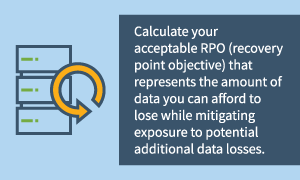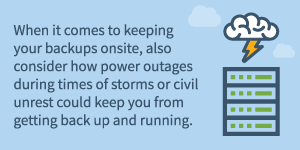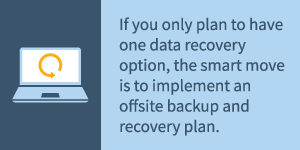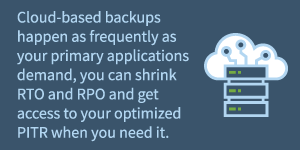
21 Feb Point in Time Recovery and the Cloud
If you’ve ever performed a system update that corrupted your database, you know first-hand how critical having optimized point in time recovery (PITR) targets can be to restoring data and getting your business back up and running.
With every aspect of your business relying on data to get things done, is it smarter to have your critical data backed up onsite, offsite, or using a cloud-based approach?
You need to have the right disaster plan in place before the inevitable failure occurs.
Creating a Data Recovery Plan
As an organization you need to determine your RTO (recovery time objective) which is the maximum amount of time your business can afford to be offline or without access to necessary data and applications.
 You also need to calculate your acceptable RPO (recovery point objective) that represents the amount of data you can afford to lose while mitigating exposure to potential additional data losses.
You also need to calculate your acceptable RPO (recovery point objective) that represents the amount of data you can afford to lose while mitigating exposure to potential additional data losses.
This is the calculation that determines how frequently the system will back up your data.
You may also have applications in your system that determine a need for different RTO and RPO tolerances. If you run an online marketplace, you may need to restore your commerce application in minutes whereas you may be able to stretch the backup demands for the company wide email to hours. Then choose your customized PITR that is the best for the way you do business.
When calculating your recovery objective values, you need to have a working list of your daily workloads. Then you will assign a tier to those programs and applications. Once you’ve identified your most critical applications, your RTO and RPO will determine the correct PITR to keep minimize data and productivity losses.
Whatever you choose, make sure you also maintain required audit trails to meet your industry’s regulatory requirements.
From this point, you can determine where to store your backups. Because the location of your backup can directly influence your real-time RTO and RPO when you need to perform a system recovery.
Option: Onsite Backups
As with any onsite solution, you need hardware that requires an in-house staff to monitor, manage, and maintain the integrity of the system. Plus, you need a recovery strategy in the event of backup failure, a natural disaster, or generalized data loss.

Onsite recovery options aren’t always very flexible. Tape drives can’t handle the demands of continuous data protection, and they are susceptible to physical damage. Drives are better and offer faster read/writes, but they take up space, and consume a lot of power. Plus, if you find you need more storage you need to purchase additional disks and install them into the system.
You can also run a dedicated backup server with redundancies designed to avoid a single point of failure. The downside is that in the event of a localized disaster scenario, your server can’t protect data or run required backups.
Option: Offsite Backups
With offsite backups your RTO, RPO, and PITR goals must be modified to consider the distance your data may have to travel to get back to you. This is especially a consideration for offsite physical backups.

You’re most likely to find that offsite storage is disk based and user-friendly. But keep that RTO and RPO in mind. Even a disk-based recovery solution takes time to recover your entire system to a point where you are fully operational.
However, when you and your backups aren’t in the same physical location your backups may be able to get started restoring critical information and getting necessary applications back up and running getting you back to business faster.
Option: Cloud Based Backups

And because cloud-based backups happen as frequently as your primary applications demand, you can shrink RTO and RPO and get access to your optimized PITR when you need it.
Have Questions about Disaster Recovery and Backups?
With so many options available to back up your business critical data, it’s easy to feel overwhelmed. Or maybe the onsite maintenance and staffing costs are impacting your bottom line.
If you want to discuss your disaster recovery options, we can help you calculate RTO and RPO and create your PITR targets for your applications. Schedule a call with one of our experts today.